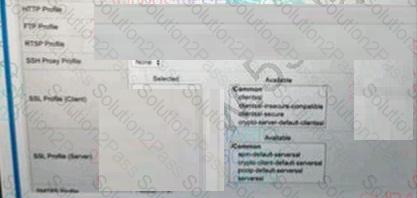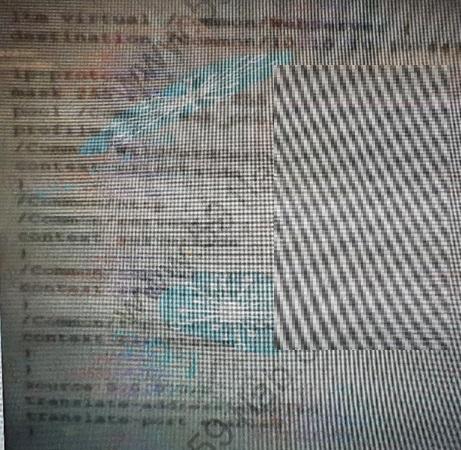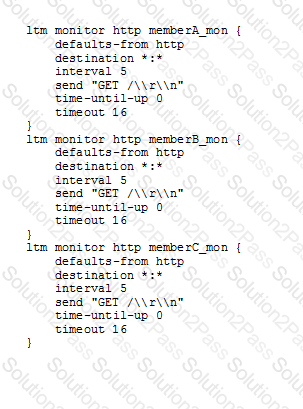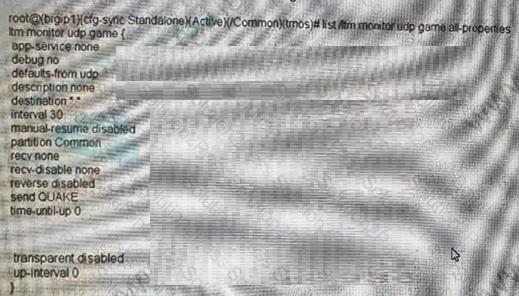303 F5 BIG-IP ASM Specialist Free Practice Exam Questions (2025 Updated)
Prepare effectively for your F5 303 BIG-IP ASM Specialist certification with our extensive collection of free, high-quality practice questions. Each question is designed to mirror the actual exam format and objectives, complete with comprehensive answers and detailed explanations. Our materials are regularly updated for 2025, ensuring you have the most current resources to build confidence and succeed on your first attempt.
A BIG-IP Administrator creates a new VLAN on BIG-IP Cluster Member A and attaches an Interface to it. Although the Auto Config Sync is in place, the new VLAN does NOT show up on Cluster Member B. What should the BIG-IP Administrator do to ensure the new VLAN is configured on each Cluster Member?
A failover event is recorded in the following log messages:
Jan 01 00:56:56 BIG-IP notice mcpd[5318]: 01070727:5: Pool /Common/my-pool member /Common/10.0.0.10:80 monitor status down.
Jan 01 00:56:56 BIG-IP notice sod[5855]: 010c0045:5: Leaving active, group score 10 peer group score 20.
Jan 01 00:56:56 BIG-IP notice sod[5855]: 010c0052:5: Standby for traffic group /Common/traffic-group-1.
Jan 01 00:56:56 BIG-IP notice sod[5855]: 010c0018:5: Standby
Jan 01 00:57:06 BIG-IP notice logger: /usr/bin/tmipsecd --tmmcount 4 ==> /usr/bin/bigstart stop racoon
What is the cause of the failover?
Refer to the following iRule:

What is a complete list of profiles that must be applied to the virtual server for this iRule?
An LTM Specialist needs to modify the logging level for tcpdump execution events. Checking the BigDB Key, the following is currently configured:
sys db log.tcpdump.level {
value "Notice"
}
Which command should the LTM Specialist execute on the LTM device to change the logging level to informational?
Refer to the exhibit.

A BIG-IP Administrator configures a Virtual Server to handle HTTPS traffic. Users report that the
application is NOT working.
Which actional configuration is regard to resolve this issue?
The following decoded TCPDump capture shows the trace of a failing health monitor.
00:00:13.245104 IP 10.29.29.60.51947 > 10.0.0.12.http: P 1:59(58) ack 1 win 46
0x0000: 4500 006e 3b19 4000 4006 ce0c 0a1d 1d3c E..n;.@.@......<</p>
0x0010: 0a00 000c caeb 0050 8be5 aca3 dd65 e3e1 .......P.....e..
0x0020: 8018 002e 1b41 0000 0101 080a 94b3 5b5c .....A........[\
0x0030: 0e30 90ad 4745 5420 2f74 6573 745f 7061 .0..GET./test_pa
0x0040: 6765 2e68 746d 6c20 4854 5450 312e 310d ge.html.HTTP1.1.
0x0050: 0a48 6f73 743a 200d 0a43 6f6e 6e65 6374 .Host:...Connect
0x0060: 696f 6e3a 2043 6c6f 7365 0d0a 0d0a 0105 ion:.Close......
0x0070: 0100 0003 00 .....
00:00:13.245284 IP 10.0.0.12.http > 10.29.29.60.51947: . ack 59 win 362
0x0000 0ffd 0800 4500 00c9 6f68 4000 8006 755d ....E...oh@...u]
0x0010 0a29 0015 0a29 0103 0050 e0d6 4929 90eb .)...)...P..I)..
0x0020 6f12 d83c 8019 fab3 9b31 0000 0101 080a o..<.....1......
0x0030 0068 4e10 5240 6150 4854 5450 2f31 2e31 .hN.R@aPHTTP/1.1
0x0040 2034 3030 2042 6164 2052 6571 7565 7374 .400.Bad.Request
0x0050 0d0a 436f 6e74 656e 742d 5479 7065 3a20 ..Content-Type:.
0x0060 7465 7874 2f68 746d 6c0d 0a44 6174 653a text/html..Date:
0x0070 2054 6875 2c20 3231 204a 616e 2032 3031 .Mon,.01.Jan.201
0x0080 3020 3138 3a35 383a 3537 2047 4d54 0d0a 2.00:00:01.GMT..
0x0090 436f 6e6e 6563 7469 6f6e 3a20 636c 6f73 Connection:.clos
0x00a0 650d 0a43 6f6e 7465 6e74 2d4c 656e 6774 e..Content-Lengt
0x00b0 683a 2032 300d 0a0d 0a3c 6831 3e42 6164 h:.20....<h1>Bad
0x00c0 2052 6571 7565 7374 3c2f 6831 3e .Request</h1>
The health monitor is sending the string shown in the capture; however, the server response is NOT as expected. The correct response should be an HTML page including the string 'SERVER IS UP'.
What is the issue?
An LTM device is load balancing SIP traffic. An LTM Specialist notices that sometimes the SIP request is being load balanced to the same server as the initial connection.
Which setting in the UDP profile will make the LTM device more evenly distribute the SIP traffic?
A web application is configured as follows:

What should be modified to set a maximum request limit?
Four members in a server pool have similar hardware platforms. An LTM Specialist needs the load balancing method that canselect the server with the fewest entries in the persistence table.
Which load balancing method should the LTM Specialist use?
The BIG-IP Administrator creates a custom iRule that fails to work as expected. Which F5 online resource should the administrator use to help resolve this issue?
A BIG-IP Administrator discovers malicious brute-force attempts to access the BIG-IP device on the management interface via SSH. The BIG-IP Administrator needs to restrict SSH access to the
management interface.
Where should this be accomplished?
-- Exhibit –

-- Exhibit --
Refer to the exhibit.
An LTM Specialist creates a virtual server to load balance traffic to a pool of HTTPS servers. The servers use client certificates for user authentication. The virtual server has clientssl, serverssl, and http profiles enabled. Clients are unable to connect to the application through the virtual server, but they are able to connect to the application servers directly.
Which change to the LTM device configuration will resolve the problem?
An LTM Specialist configures a new virtual server with a single pool member. The LTM Specialist has NOT defined a health monitor for the pool, pool member or node.
What is the status of the virtual server?
During a high-demand traffic event, the BIG-IP Administrator needs to limit the number of new
connections per second allowed to a Virtual Server.
What should the administrator apply to accomplish this task?
Active connections to pool members are unevenly distributed. The load balancing method is Least Connections (member) Priority Group Activation is disabled. What is a potential cause of the event distribution?
A VCMP guest has the following characteristics:
• Resources allocated for CPU memory, network interfaces, and disk space
• Virtual disk created
• The guest is NOT running
The guest isNOT running in which state is the VCMP guest
in which Application Visibility and Reporting (AYR) profile must the SMTP profile be defined to configure notifications via email?
An organization’s development team creates an application to put behind the F5LTM device. The application can be quite load intensive at first, and then evens out over time. The team’s load balancing method needs to select a pool after taking into account the pool member’s response over the time to avoid landing on a busy pool member.
Which of the following load balancing methods meets this requirement?
A BIG-IP Administrator needs to find which modules have been licensed for use on the BIG-IP system. In which section of the Configuration Utility can the BIG-IP Administrator find this information?
Exhibit.

Webserver_pool consists of 6 members. phpAuction_80_pool consists of 2 members LTM1 is the current Activemember.
LTM1 loses connectivity to 3 of the 6 members in the webserver_pool LTM2 still has connectivity to all
servers.
What is the expected failover behavior?
A BIG-IP Administrator adds new Pool Members into an existing, highly utilized pool. Soon after, there are reports that the application is failing to load for some users. What pool level setting should the BIG-IP Administrator check?
The picture belongs to static content, you can configure static content cache in FS to meet this demand
An LTM Specialist must configure session persistence for a highly available, highly utilized web-based application.
* The following requirements are provided:
* http proxy setup for security
persistence information available to the HA peer in case of failover
The LTM Specialist needs to minimize additional burden on the LTM device to the greatest extent possible.
Which persistence profile should be used?
-- Exhibit –


-- Exhibit --
Refer to the exhibits.
How should the LTM Specialist minimize the configuration?
An LTM Specialist must reconfigure a BIG-IP system that load balances traffic to a web application. The security department has informed the LTM Specialist that the following cipher string must be used for TLS connections from BIG-IP to the web application.
NATIVE:IMDS:EXPORT:IDHE:EDH@SPEED
In which virtual server profile should the cipher string be configured?
A BIG-IP Administrator needs to install a HotFix on a standalone BIG-IP device, which has HD1.1 as the Active Boot Location. The BIG-IP Administrator has already re-activated the license and created an UCS archive of the configuration. In which sequence should the BIG-IP Administrator perform the remaining steps?
An LTM Administrator receives an email from the NOC stating that the switch connected to the backend server was shut down for maintenance. The BIG-IP device handles only UDP traffic. The BIG IP device did not fail over to a DR location when no pool members were available.
When theLTM Administrator checks the pool, it confirms that the monitor is still marking UP the pool member.
A tcpdump of the traffic shows the following output:

A list of the monitor configuration shows the following:

Which two modifications to the LTMconfiguration will mark this pool member down, when the switch is down? (Choose two.)
A 8IG-IP device is replaced with an RMA device. The BIG-IP Administrator renews the license and tries to restore the configuration from a previously generated UCS archive on the RMA device. The device configuration is NOT fully loading. What is causing the configuration load to fail?
A BIG-IP device is configured with both an internal external and two Corporate VLANs. The virtual server
has SNAT enabled and is set to listen on all VLANs Auto Last Hop is disabled. The Corporate users are on
10.0.0.0./24 and 172.16.0.0/12. The BIG-IP has a Self-IP on the 1.0.0.0.0./24 subnet.
Internet users are able to access the virtual server. Only some of the Corporate users are able to connect
to the virtual server A BIG-IP Administrator performs a tcpdump on the BIG-IP and verifies that traffic is
arriving from users in 10.0.0.0/24.
What should the BIG-IP Administrator do to correct this behaviour?
-- Exhibit –

-- Exhibit --
Refer to the exhibit.
An LTM Specialist is upgrading the LTM devices.
Which device should be upgraded first?
An LTM Specialist has been asked to configure a virtual server to distribute connections between a pool of two application servers with addresses 172.16.20.1 and 172.16.20.2. The application servers are listening on TCP ports 80 and 443. The application administrators have asked that clients be directed to the same node for both HTTP and HTTPS requests within the same session.
Virtual servers vs_http and vs_https have been created, listening on 1.2.3.100:80 and 1.2.3.100:443, respectively.
Which configuration option will result in the desired behavior?
